Your Summer Lawn Troubleshooting Guide
05 July 2024
(Last updated: 5 Aug 2024 14:06)
How to diagnose and treat problems with your lawn during the summer months.
Picture this. It’s summer and you are looking forward to spending as much time as possible in your garden with friends and family. But oh, dear, your lawn looks dreadful and you don’t know what to do about it.
Our summer lawn troubleshooting guide will help you to find the solutions you need. Here’s what we’re going to be looking at. Please feel free to scroll through the article where you’ll find pictures of lawn problems as well as explanations and suggestions for speedy improvements.
• Pale or yellowing leaves - a disappointing colour throughout the lawn.
• Weirdly shaped discoloured patches with a slight pink tinge to them
• Brown tipped leaves with ragged edges
• My lawn has lost it’s ‘spring’ and looks flat and sad
• Areas of dead grass edged with dark green
• Stripes or swirls of differently coloured grass
• Ants in the lawn
• Most or all of the lawn is honey-coloured with very little green to be seen
• Some of the grasses have different colours or textures and look ugly
Help! My Lawn Looks Sick
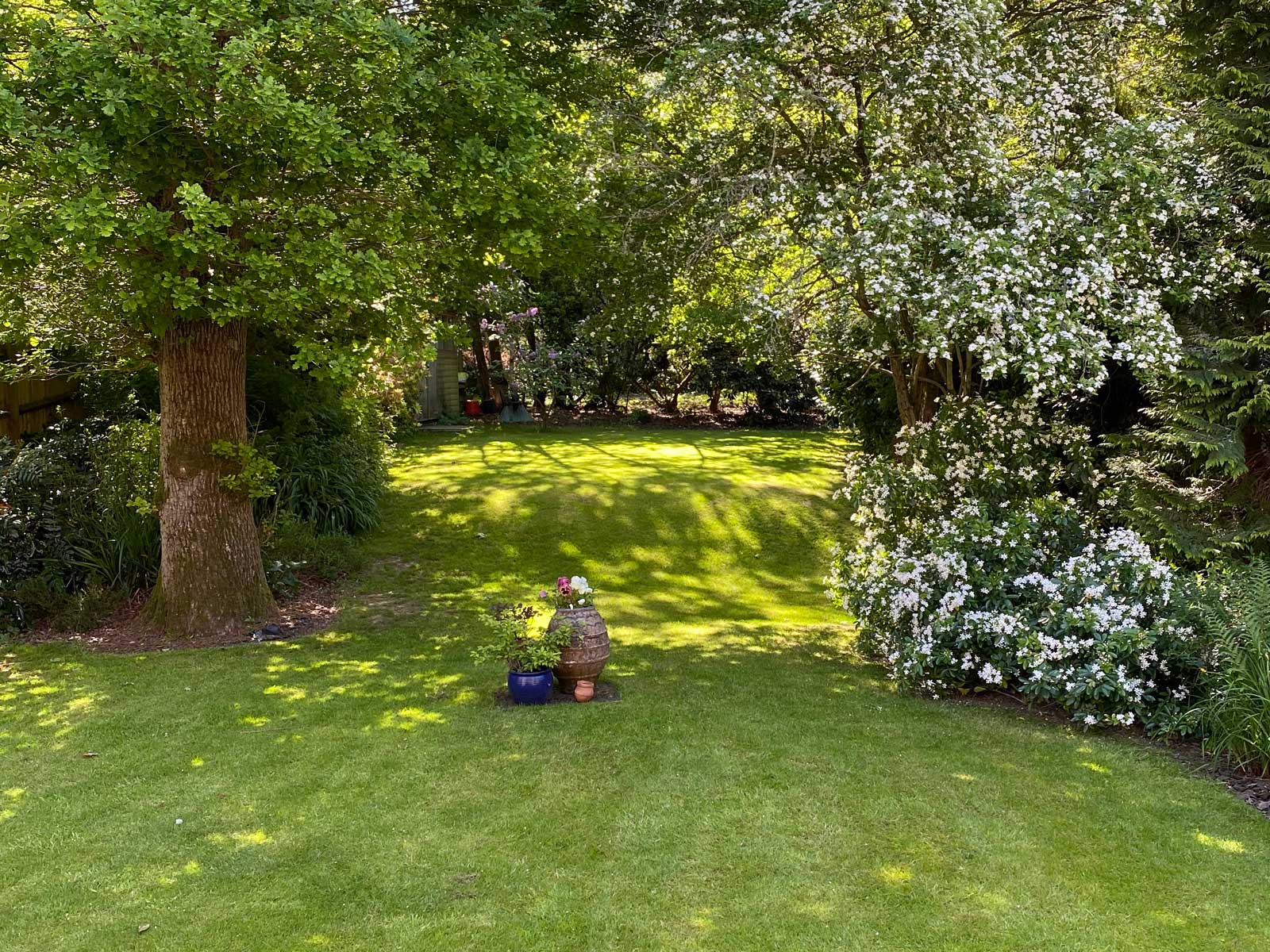 Sometimes it’s difficult to put your finger on why you’re not happy with your lawn’s appearance. In some cases it just looks ‘wrong’.
Sometimes it’s difficult to put your finger on why you’re not happy with your lawn’s appearance. In some cases it just looks ‘wrong’.
More often than not, if the grass blades are good and fat, but they’re more of a yellowy-green than a deep green, the plants are simply in need of more nutrients, or water, if conditions have turned dry. Applying a fertiliser that’s appropriate for the time of year and then boosting it with a foliar feed will likely see the colour return in a matter of weeks. Only use a drought-safe product if fertilising in hotter conditions.
If however, your grass is looking pale and is producing especially weak growth, that could be due to lack of sunlight. Grass needs plenty of sunshine to support a process called photosynthesis which is how plants get their energy.
In shaded conditions, some grass species fare better than others. If your lawn is struggling in low light conditions, raise your mower blades as far as you dare to maximise the surface area of the leaves. Then implement a regular regime of feeding and treatments. In the autumn time, consider re-seeding or overseeding with a mix of shade tolerant grass species.
Maintaining a beautiful lawn in a shaded garden requires skill and expertise. UKLCA members have a deep knowledge of cultivating grasses in challenging conditions
What Are These Pink Patches In My Lawn?
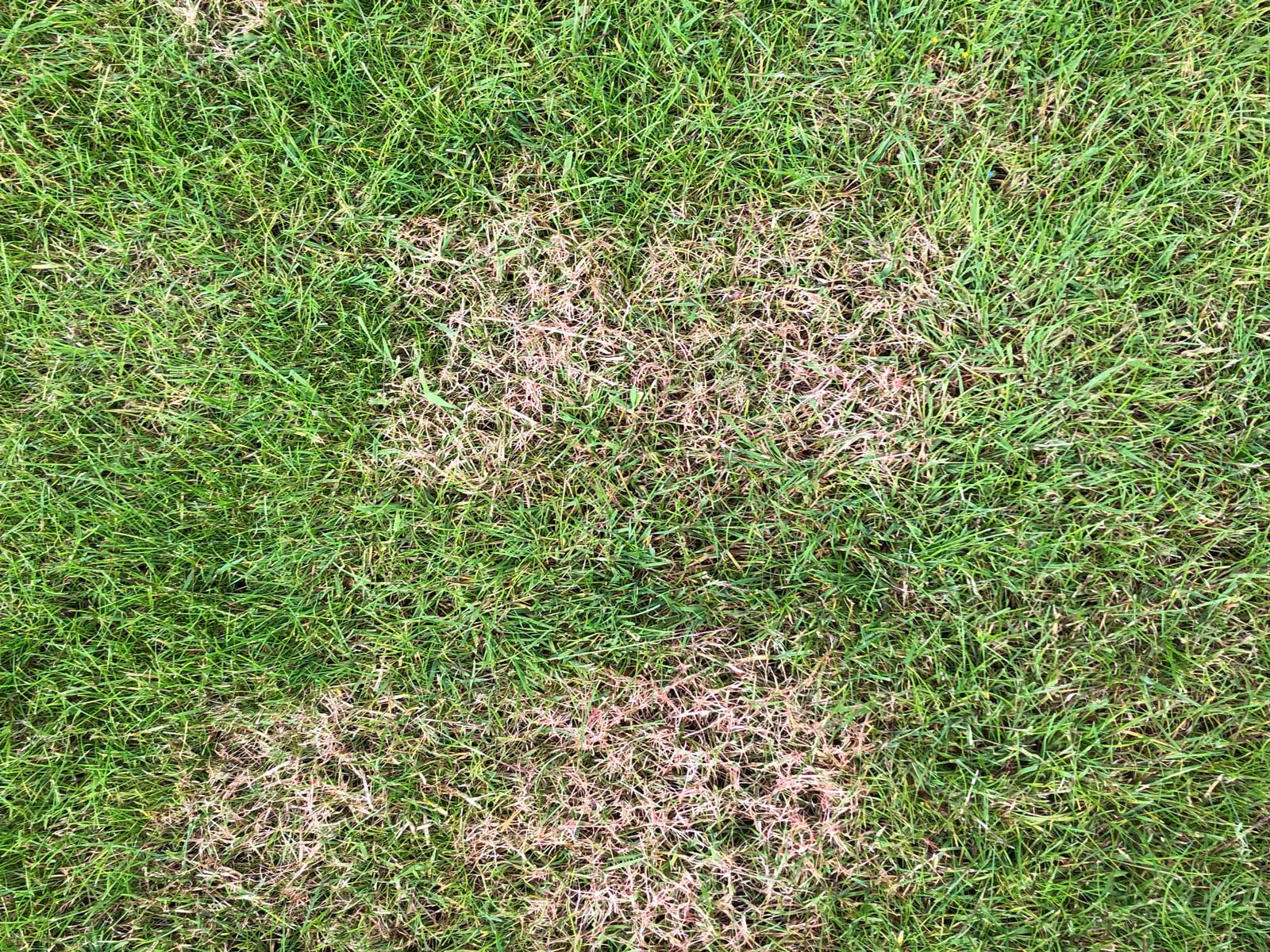 Irregularly shaped patches of pinky-beige coloured grass are a good indication that your lawn is suffering from red-thread disease. Red-thread is caused by a fungus that normally lives quietly and discreetly in your lawn. When grass is in tip top condition it resists the ravages of red thread and you wouldn’t know it was there at all. But, when grass is a wee bit hungry or stressed, then the disease is more likely to attack the sward. (A bit like you and me - we’re more likely to succumb to colds and flu if we’re a wee bit run down.)
Irregularly shaped patches of pinky-beige coloured grass are a good indication that your lawn is suffering from red-thread disease. Red-thread is caused by a fungus that normally lives quietly and discreetly in your lawn. When grass is in tip top condition it resists the ravages of red thread and you wouldn’t know it was there at all. But, when grass is a wee bit hungry or stressed, then the disease is more likely to attack the sward. (A bit like you and me - we’re more likely to succumb to colds and flu if we’re a wee bit run down.)
Firstly, if you haven’t already done so, feed your whole lawn. Ideally with a feed that contains Iron to boost resistance and improve the colour.
To avoid spreading red thread disease, be sure to disinfect your mower after each trim whilst the disease is active.
If the disease is raging or if it just won’t go away, call a lawn care specialist who will be able to supply and apply stronger treatments.
Why Does My Lawn Look So Ragged?
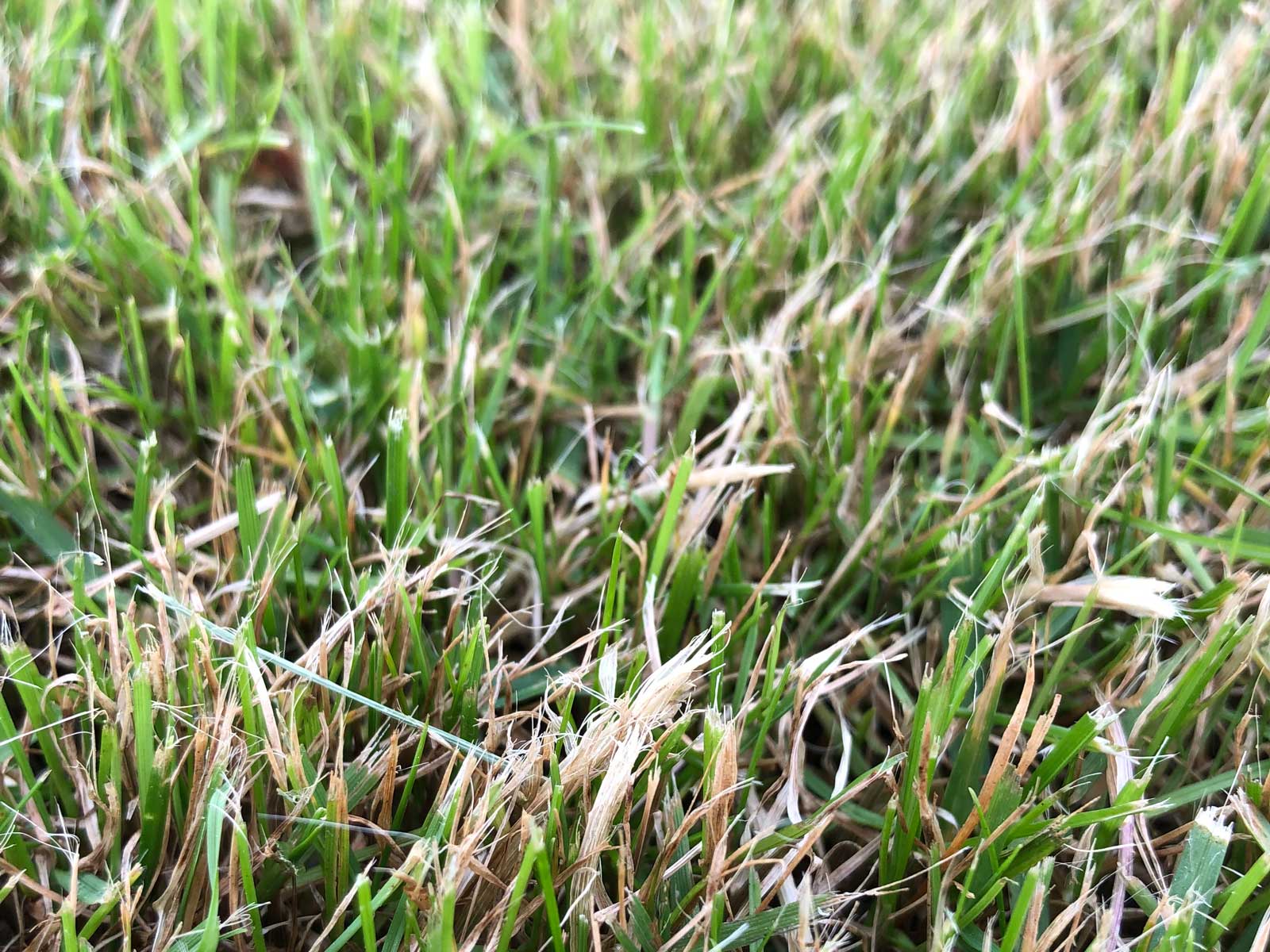
Ragged edges to the tips of your grass plants is a sure sign that your mower blades are blunt. Instead of slicing cleanly through the vegetation, your mower is ripping at the leaves and causing unsightly damage. Those ragged edges not only look ugly, they take a long time to heal and could potentially encourage disease.
Sharpening or replacing your lawn mower blade will solve the problem in an instant. If you don’t know how to do it yourself, most garden centres will be able to recommend a lawn mower repair shop.
My Lawn Has Lost Its Springiness
It’s so difficult to describe lawn problems in writing. But if you can walk across your lawn in summer time and then look back and see your footprints, the chances are that the grass is dehydrated.
The obvious answer is to water your lawn. However, lawn irrigation is not always a great use of such a precious resource as water. If your lawn is flagging from heat or drought, be kind to it. Try to avoid walking on it, and if you do mow, keep the blades as high as you dare.
To improve drought resistance in the longer term, hire a lawn care specialist to scarify, aerate and treat your lawn in autumn time. Looking after the plants and soil in this way will encourage the grass to grow longer, stronger roots so that they can access deeper groundwater during periods of low rainfall.
What Are These Ugly Scars On My Lawn?
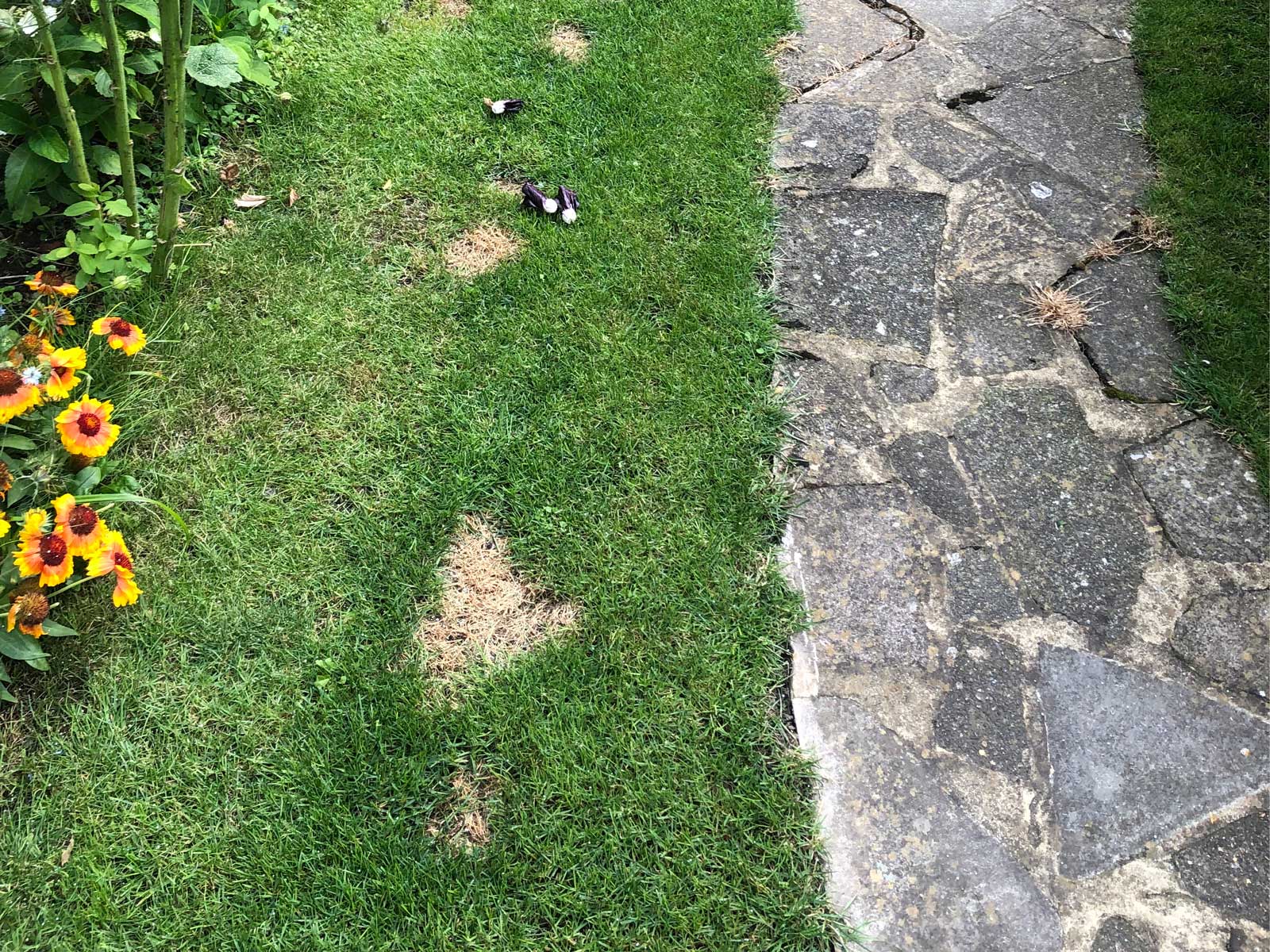 Lawn lovers who have pets and/or visiting wildlife will almost inevitably see the occasional urine patch on the lawn.
Lawn lovers who have pets and/or visiting wildlife will almost inevitably see the occasional urine patch on the lawn.
These patches are characterised by irregular shaped areas of either longer, greener grass, OR bleached grass surrounded by dark green growth.
Urine scorch is caused by the ammonia in an animal’s pee. Ammonia breaks down in the soil to make nitrate, which, as you know, is a plant nutrient. Hence, the darker, lusher, greener growth. But, like all good things, it is possible to have too much of it. Excess nitrates will scorch and even kill plants….hence the brown scars on the lawn.
What can you do? Well you can follow your pet around the garden with a bucket of water to dilute the pee every time they ‘go’. But that’s quite time consuming. You can train your dog to do their business in another part of the garden. Or you could ask your vet for advice on how to adjust the dog’s diet to reduce the amount of ammonia in their pee.
I’m Seeing Strange Markings In The Grass. What’s Going On?
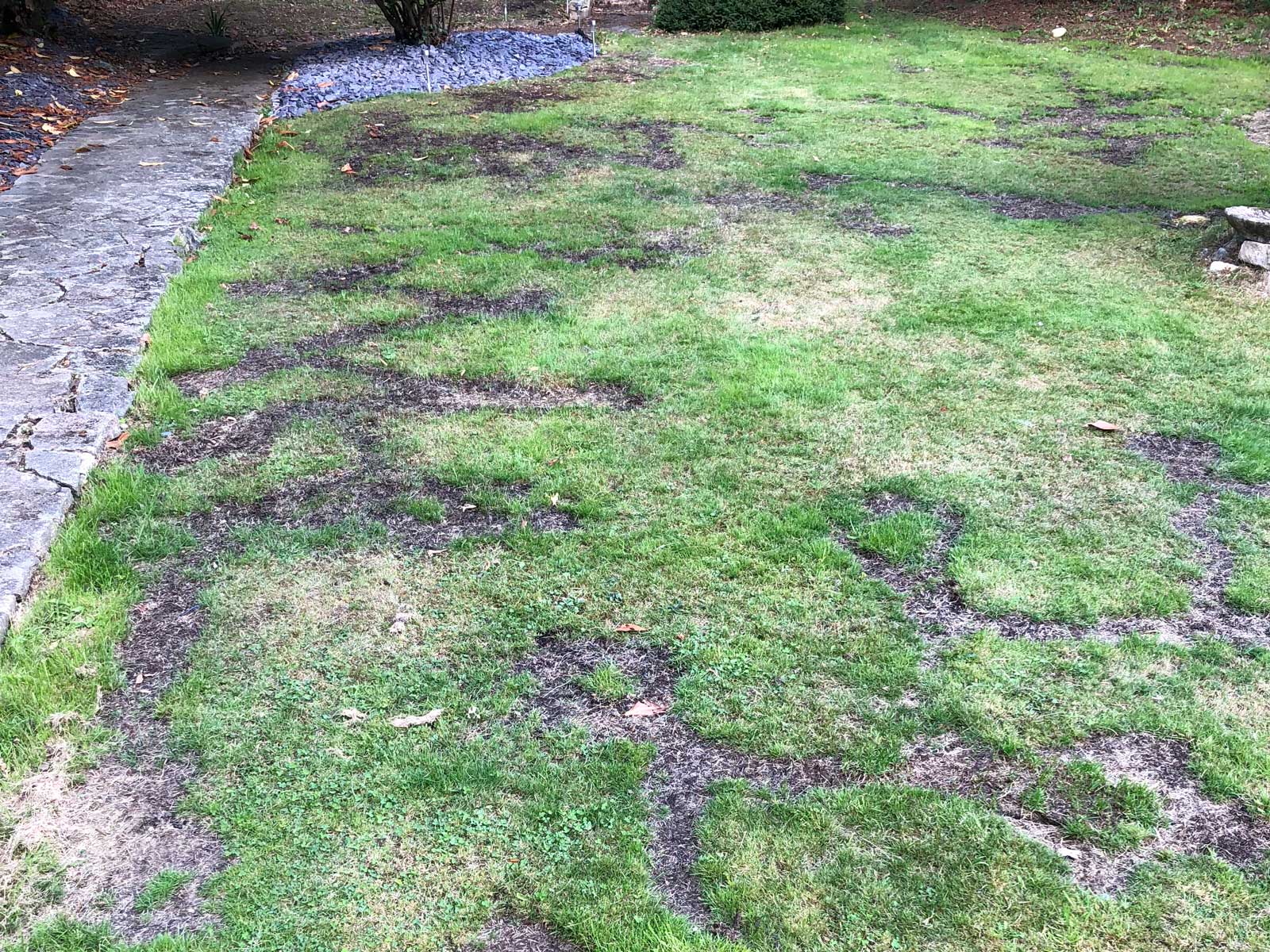 In the paragraph above we talked about dog pee and how excess nitrates can affect the colour of grass. If you are seeing strange markings in your lawn, it’s more than likely that fertiliser has been applied unevenly.
In the paragraph above we talked about dog pee and how excess nitrates can affect the colour of grass. If you are seeing strange markings in your lawn, it’s more than likely that fertiliser has been applied unevenly.
Is there one area round about where you filled your fertiliser spreader? Could some of the lawn feed have been spilled?
Are there regular stripes that are either paler or darker than the rest of the grass? Those stripes have likely either had too much or too little feed. Check the calibration of your spreader and be very careful about spacing when you are walking up and down with it. The same applies to applying lawn treatments. Calibration and spacing are crucial.
Are the different coloured areas swirly or patchy? Did you broadcast your fertiliser by hand? This is a very risky practice! Invest in a good fertiliser spreader or hire a lawn care professional to look after feeding and treatments.
Ants In Your Lawn
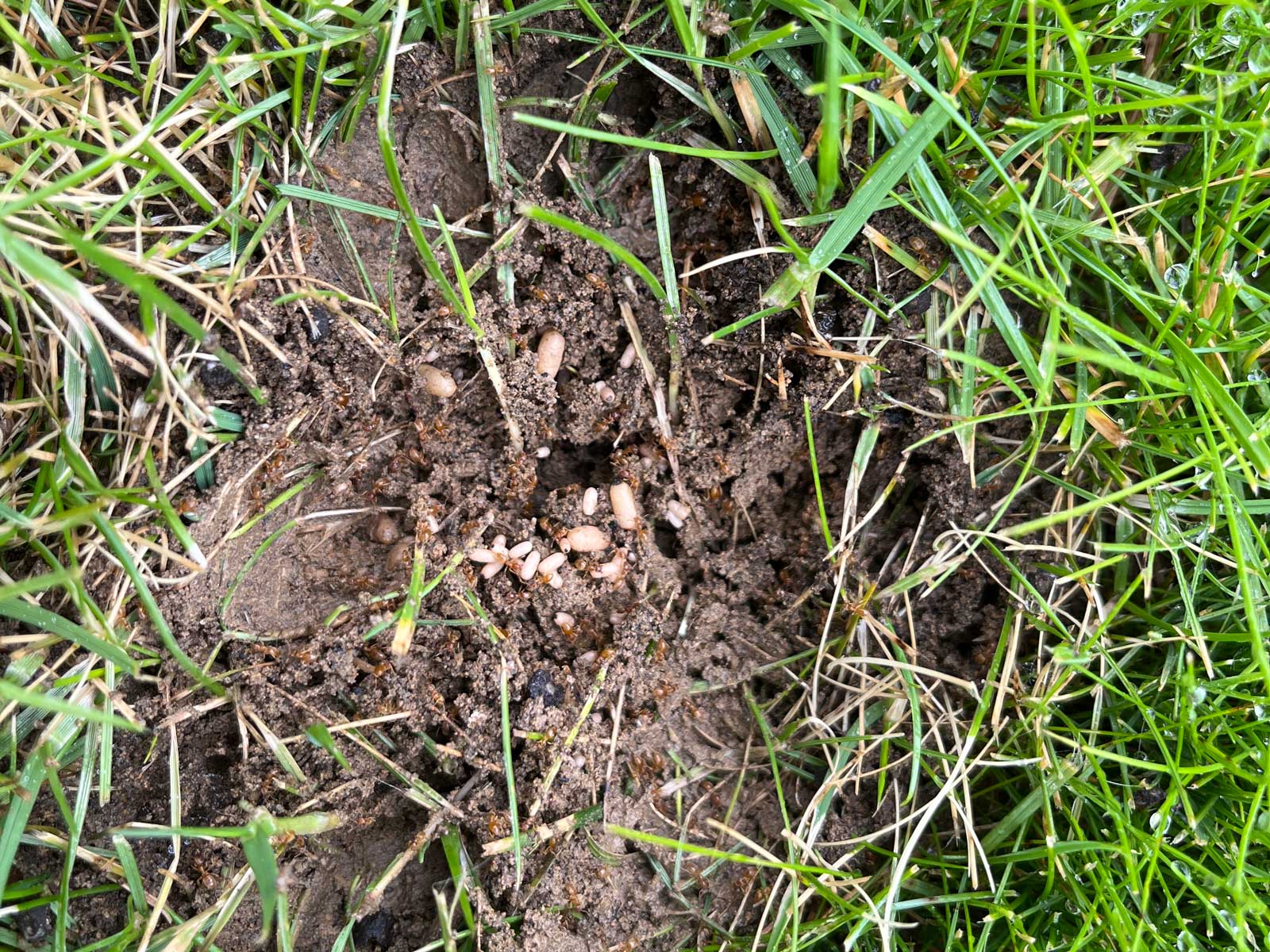 Oh dear, ants simply love lawns and if they’ve moved into yours your probably not at all happy.
Oh dear, ants simply love lawns and if they’ve moved into yours your probably not at all happy.
But don’t panic, there is a simple solution and it’s probably sitting on your kitchen shelf right now. Peppermint essence. Yes, ants hate peppermint and at the slightest whiff of it they’ll up sticks and move on.
Dissolve four of five drops of peppermint essence in a tablespoon full of vodka. (The essence is an oil so it won’t mix with water.) Now dilute your vodka mix with a cup full of water in a small, hand held sprayer bottle. Then simply spritz the ant nest with the mixture. Repeat daily until they move on. This treatment won’t hurt the lawn, it won’t damage the environment and it’s pet-friendly too. So much more pleasant that toxic ant powders!
My Lawn Has Turned Brown All Over
It’s perfectly normal for a lawn to turn brown in summertime. That’s all part of the plants’ natural reaction to drought. Irrigation will return it to green, but unless you desperately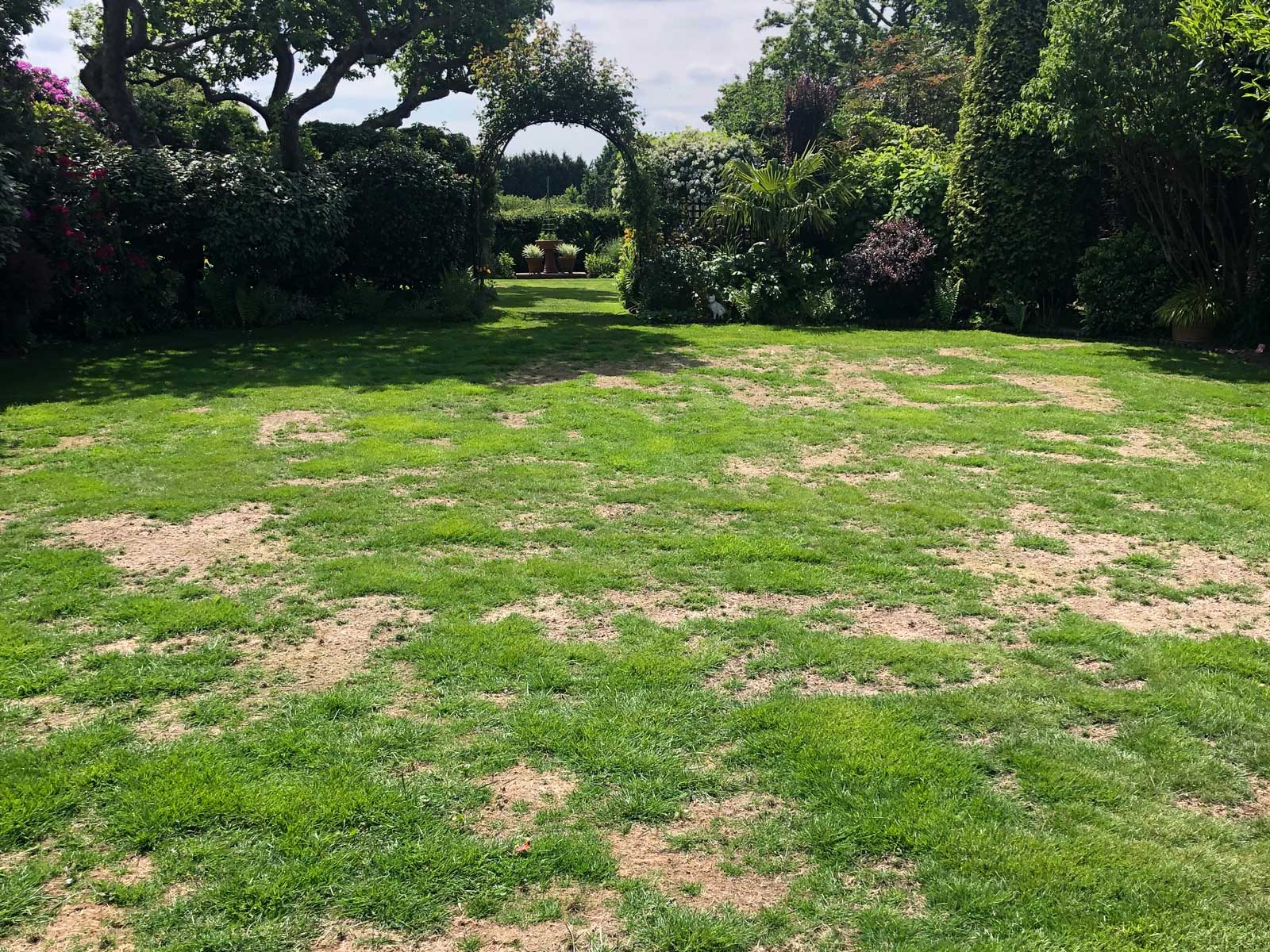 need your lawn to be verdant, it’s more environmentally friendly to wait for rain.
need your lawn to be verdant, it’s more environmentally friendly to wait for rain.
Most of the time, drought damaged lawns will make a full recovery once the rain comes. However, if parts of your lawn appear not to have survived the drought, seek expert help to diagnose and rectify the problem.
If your lawn is brown and you’re positive that drought is not the problem, have a think about what could have happened to it. Has anyone applied any feeds, weedkillers or other treatments? Could they have made a mistake with the dosage or used a contaminated sprayer?
What’s happening in the wider environment? Are the other plants in your garden in good health? For any mystery lawn ailments, please don’t hesitate to contact a lawn care specialist. They will help you get to the bottom of the problem and find a solution for it.
Let’s Talk About Weed Grasses
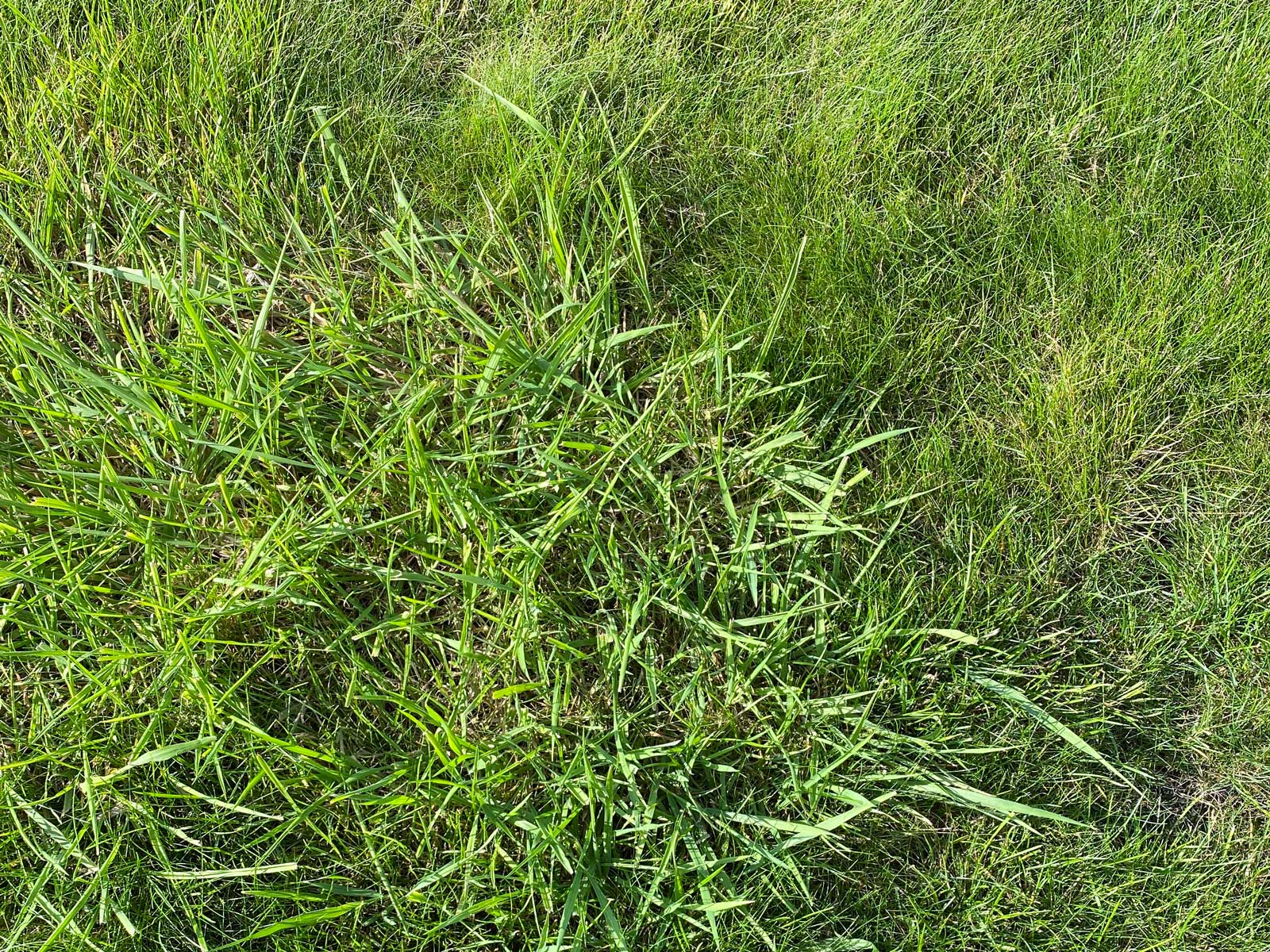 Broadleaved weeds in a lawn are very easy to see and relatively simple to treat. But weed grasses are sneaky. Very often you don’t spot them until they are well established.
Broadleaved weeds in a lawn are very easy to see and relatively simple to treat. But weed grasses are sneaky. Very often you don’t spot them until they are well established.
Take Poa annua for example, aka annual meadow grass. It’s a naturally occurring species that’s almost impossible to avoid. It grows anywhere and everywhere and the seeds will either blow onto your lawn or be dropped there by birds. For most of the year, you won’t notice annual meadow grass, but when it decides to have a growth spurt, to set seed, or to react differently to weather conditions, then you’ll definitely know you have it.
When it’s under stress, annual meadow grass loses it’s colour and appears as yellowish blobs against a background of healthy green grass. In spring, its fluffy seed heads are obvious and if you have a fine lawn with slender bladed grasses then oh dear, AMG creates ugly clumps in the sward.
Controlling weed grasses requires patience and consistency. If there’s just a few rogue plants, you can manually remove them and re-seed the space they leave. If your lawn is infested, then please seek expert advice.
Getting The Right Help For Summer Lawn Problems
If something’s not right with your lawn, don’t waste time worrying about it or trying to fix things yourself. There are experts out there who have access to specialist equipment and professional grade treatments that can repair your lawn surprisingly quickly.
Your first port of call should always be the UK Lawn Care Association. UKLCA members are experience professionals and we’re certain that there’ll be at least one of them working in your area. Use the search facility on our website to get the right help with your summer lawn problems.
Here’s how to find a great lawn care specialist near you.
View other News